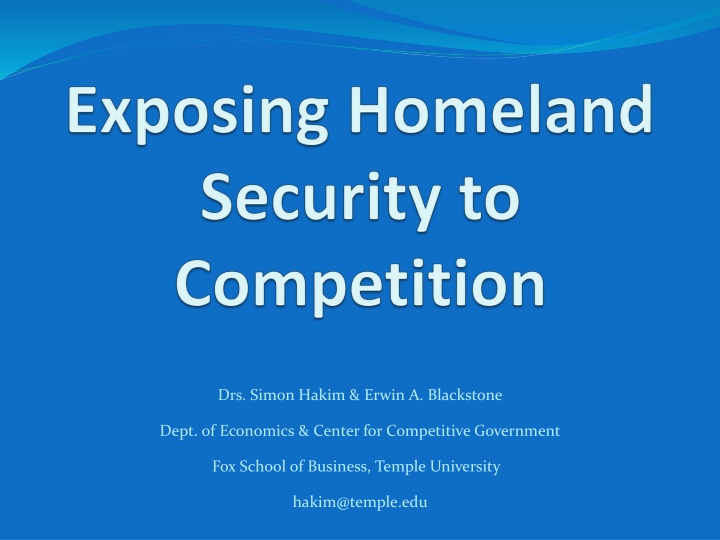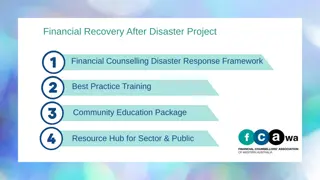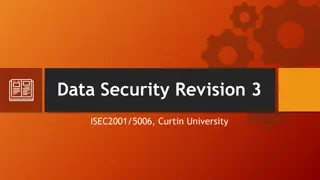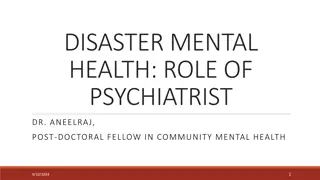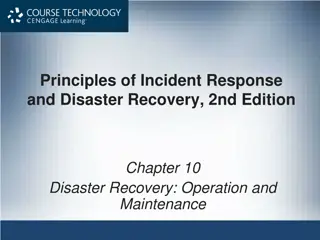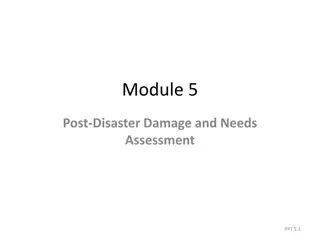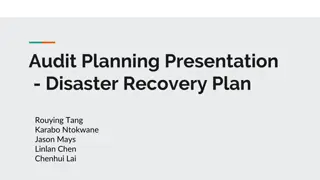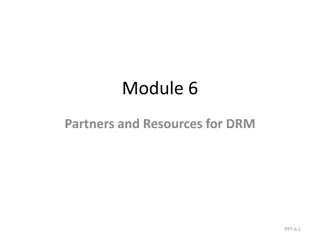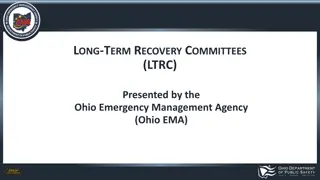Addressing Social Inefficiency in Disaster Recovery and Response
Drs. Simon Hakim and Erwin A. Blackstone from Temple University discuss the challenges of global warming and terrorism in disaster recovery. They propose a new approach involving interdisciplinary sources like Public Administration and Homeland Security to improve government response. The research focuses on factors contributing to social inefficiencies, such as short-term views and errors in decision-making, and offers solutions for better disaster preparedness.
Download Presentation

Please find below an Image/Link to download the presentation.
The content on the website is provided AS IS for your information and personal use only. It may not be sold, licensed, or shared on other websites without obtaining consent from the author.If you encounter any issues during the download, it is possible that the publisher has removed the file from their server.
You are allowed to download the files provided on this website for personal or commercial use, subject to the condition that they are used lawfully. All files are the property of their respective owners.
The content on the website is provided AS IS for your information and personal use only. It may not be sold, licensed, or shared on other websites without obtaining consent from the author.
E N D
Presentation Transcript
Drs. Simon Hakim & Erwin A. Blackstone Dept. of Economics & Center for Competitive Government Fox School of Business, Temple University hakim@temple.edu
The Problem Global warming, and a rise of extreme religiously related terrorism have already raised and are expected toyield severedisasters. Government recovery efforts from natural and manmade disasters appeared to have failed or had limited success. Examples include Katrina in the US and the 2ndLebanese War in Israel. led preparation, response, and
Interdisciplinary Sources Public Choice Public Administration Regional Science Homeland Security
Chart of Research Methodology Problem Variables Solution Factors Our Plan FEMA just provides lump sum financing. PPVP is in charge of all activities and budget allocation in region. PPVP comprise localities facing similar threats, flexible structure, for peak load use semi- skilled workers & equipment in region, pre-registry & pre-contract of public & private equipment available in region. Short term view .a Type 1 & 2 errors .a Regionalism (h, I, j) Visibility & political gain .a Tragedy of the common .a Unpredictable impacts .a Controls vertical & horizontal jurisdictions, controls all 3 stages, full financial control, attract experienced top management or entrepreneurial executives, PPP & PPVP (c, e, i) Moral Hazard .a Misinformation .a Controls vertical & horizontal juris Dictions, controls all 3stages, full financial control, attract experienced top management or entrepreneurial executives, Government Bureaucracy .a Leadership & Flat Hierarchy (a, b, c, d, l) Overlapping jurisdictions .a Peak Load .a Online bidding, accountability, Efficient control, savings; ubiquitous information, less regulation needed Greater competition (g, h) Monopoly inefficiency .a
Reasons for Social Inefficient Behavior 1. Short term view Immediate success to satisfy the public. Visible services tend to be over-funded while longer term success like HLS tend to be under-funded. Examples include fortifying levies in New Orleans, and under-funding pensions and retiree healthcare.
Reasons for Social Inefficient Behavior 2. Type 1 and 2 errors Type 1 error is when a risky action is taken and turns out to be undesired (false). As such public officials are blamed. Type 2 action is when no action is taken and people get hurt, however officials cannot be easily blamed. Everyone observes when a mistake is done while avoiding a risky action is less noticeable and blame cannot be easily attributed. Thus, officials are risk averse and avoid type 1 errors. Example, delaying summer evacuation when a hurricane is expected at low probability.
Reasons for Social Inefficient Behavior 3. Visibility and political gain Both elected officials and bureaucrats allocate resources on visible activities that benefit constituents and glorify them while minimizing spending on behind the screen homeland security activities that may yield higher net social benefits.
Reasons for Social Inefficient Behavior 4. Tragedy of the commons Markets may result in levels of protection against disasters that are below their own private values. As more private infrastructure companies participate in any local market, competition stiffens, and more resources are shifted from non- immediate functions to satisfy short term efficient production needs that lower costs. Competition forces firms to lower costs and shift resources from research and development and security to direct marketing and production
Reasons for Social Inefficient Behavior 5. Unpredictable impacts of disaster Public decisions about spending on homeland security should depend on social cost-benefit findings that include external costs. Private infrastructure companies base their spending on security mainly on private costs and benefits that accrue to them in disaster while ignore or at least under estimating external costs. Also, the risk or the probability and expected loses of a disaster occurrence are often unknown which further yields cost estimated to be inaccurate. Thus, both public and private entities cannot determine the correct spending on security.
Reasons for Social Inefficient Behavior 6. Moral Hazard When private infrastructure managers expect the federal and state governments to compensate them for damages resulting from a disaster, they undertake fewer or less precautions than is socially appropriate. The same is true for localities that underspend on security expecting state and federal governments to defray damages if a disaster occurs. Prescott and Kydland (1977) suggest that rational actors take into account future government actions in calculating their long term present value. For example, government could announce that it does not support protection against floods in a specific floodplain. However, private contractors will build in the area knowing that once buildings are erected, government will protect them in spite of past announcements. Thus, current decisions become suboptimal because government will respond tode-facto future situations.
Reasons for Social Inefficient Behavior 7. Information and Preference Revelation Since victims receive from government free assistance and monetary payments for losses, they have incentive to inflate the amount requested. In practice, since the claims are managed by insurance companies and in many cases are assigned to independent adjusters who are often paid a percentage of the claims, the approved amounts are likely to be inflated. Thus, in expectation of government or insurance higher compensation than real damages, businesses and households invest less on protection than they would have if compensation was not expected.
Reasons for Social Inefficient Behavior 8. Government Bureaucracy The large size and multiple bureaucratic levels of government, and perceived zero marginal cost of their workers makes the approval process for funding and supply cumbersome and time consuming for both response and recovery efforts. This complex process for approval of activities that traverses through several individuals makes obstruction easy and is referred to as the Tragedy of the Anti-Common. In large bureaucratic corporations, this phenomenon of difficult approval for action has been called the problem of the abominable no-man. This phenomenon is common for most large organizations that enjoy monopolistic power. In large business and government entities, executives experience lack in managerial control due to information lost in a multilevel managerial hierarchy. As such, these entities experience diseconomies of scale in comparison to smaller entities with flatter hierarchy where information is easier transmitted, and thus their executives maintain greater grasp of the operation. (Canback, 2006.) Bureaucracy in multilevel large entities often contributes to rigidity in behaviorand performance.
Reasons for Social Inefficient Behavior 9. Overlapping Jurisdictions Local, state, and special districts often overlap in their responsibilities over the same critical infrastructure (CI). The fragmentation and overlapping jurisdictions to secure and maintain CI like levees in New Orleans enabled each agency to avoid its responsibility.
Reasons for Social Inefficient Behavior 10. Peak load problem Police, fire and medical services are designed in size and content for their normal and not for unforeseen disaster time demand. The common unresolved problem is when a disaster occurs at often unpredictable time and scope, the demand for public emergency services increases beyond existing capacity. Under the prevailing framework, state and federal agencies provide the necessary resources when disaster occurs at zero prices. Thus, the demand for emergency services at disaster time is greater than availablesupply by government provided at 0 price..
Reasons for Social Inefficient Behavior 11. Monopoly Inefficiency All three levels of government often have insufficient resources at times of disaster. However, such resources are typically available in the region with private or other public jurisdictions that could be easily mobilized with early or advance preparation. Also, government, like business monopolies or dominant firms in general, are slow to innovate, often waiting for another firm to innovate and if the innovation proves successful, the monopoly firm then copies the innovation and sometime even supplants the innovating firm.
Reasons for Social Inefficient Behavior 12. Lowprobability-highcostevent Executives in both the public and private sectors consider the expected costs realized to their entity in their decision whether and how much to invest in preventive activities. The expected cost is the multiplication of the perceived probability of a disaster by the cost that will be realized if it occurs. There are several reasons for favoring investment in high probability adverse event rather than in a lower probability similar such event when both investments yield the same reduction in the expected costs. Thus, both public and private entities underspend on prevention activities than even desired for its own welfare.
Could Adverse Effects Be Mitigated Theory and experiences suggest 4 factors that address the above stated problems, and will serve to develop our organizational model: Regionalization Leadership & flat hierarchy for control & management PPP & PPVP Exposure to market forces
Our Model From above: FEMA plays a dual role assisting localities in the event of a declared national disaster. It provides both funds and actual services for response and recovery efforts. Equipment and Services from its own warehouses or purchased in open markets are provided at a zero price. 3 reasons for FEMA s inefficiencies: monopolistic stance, lack of onsite information, and the dual role it holds.
Our Model FEMA will concentrate just in funding Funding as lump sum amount of opportunity costs Standards for compensation Shifting production & supply to competitive regional councils.
Our Model: Regionalization Transfer responsibilities and control from federal, state, and local public entities to a regional council. Create regional supplies and labor registry, and warehouses. Bidding for capital, labor & supplies rendered at disaster time at predetermined competitive prices. Most goods & services will be provided in a monopolistic competitive type markets where private, public, volunteer entities could bid.
Our Model: Regionalization Flexible borders for the regional council. Could cross state lines. The council could address the impacted region. Regional council for HLS be established just for high risk regions. Council composed of regional stakeholders relevant for preparation, response and recovery efforts Registry & pre-contract for labor & capital Regional emergency warehousing.
Our Model: Management Public-Private-Volunteers Partnership Council is in charge of all preparation, response, and recovery efforts. Regional resident leader. Preferred a volunteer. Leader/Council have power in selecting core managers. In emergency, controlling power on existing local and county governments. The council assumes full emergency control on the impacted region, and services that are usually performed by individual jurisdictions. Flat hierarchical structure with great decision making power to front volunteers/workers.
Our Model: Leadership A leader residing in the region with successful experience in leading a large public or private enterprise preferable managing crises situations. A volunteer who chooses to contribute to society, and could attract other mid-level executives to join the club. Long term commitment for preparation, response and recovery activities. Serves on both capacities of chairing the council and presiding the management team. Assumes government leadership power in emergencies.
Our Model: Equipment Peak time demand. Excess demand at disaster Resources are available within the region and vicinity. Registry. Public & private resources. Prior bidding. Regional warehouses. Early protocol for action at disaster time.
Our Model: Labor-Existing Conditions Peak time demand. Excess demand for emergency personnel beyond peacetime public capacity. Experience shows that many public emergency personnel are absent at time of disaster helping their family. Need for semi skilled personnel with basic training. National data show more than 3 times private security guards than federal, state and local law enforcement personnel. Private security personnel are mostly idle at disaster. Emergency personnel (e.g. medical) is idle at time of disaster and available for public use (Late Mayor Menino s initiative in Boston).
Our Model: Labor Train, assign, and pay personnel for emergency peak time demand situations. Included, private security guards, all medical personnel for neighborhood centers (e.g. Boston), drivers, mechanics, and IT operators. Use of the region s labor supply may yield lower social cost than the employment of the National Guard. Possibly deputize temporary key security guards who fulfill police tasks. Recruit, train, and assign in advance volunteers. Limit on the spot volunteers unless especially needed (e.g. medical personnel.) Volunteers can be signed up at colleges and universities, churches and fraternal organizations, retiree, and emergency response groups.
Four Keys For Success The leader operates under the auspices of the Council that controls the entire homeland security budget and is not dependent on various political jurisdictions for funding. The Council replaces other political jurisdiction on all homeland security issues and is not created as an additional layer. Allowing the Council to keep their savings. The incentive to save and use the extra resources to enhance homeland security services in the region encourages innovation and efficient use of resources as evident in other competitive markets. Council selects the leader to head the operations of the Council. The leader should not be subjected to political or narrow business pressure, and is financially secure. Public Private Partnerships usually improve efficiency in service delivery over that of monopolistic government, and volunteers brings it closer to the social optima.
Market Orientation Regulation that requires CI to insure for direct and external costs of a disaster. Insurance policies for homeland security require various deductibles that allow the insurer to encourage some preventive activities. Insurance companies will design how to reduce risk exposure and discounts that could encourage mitigating activities by CI owners. Competition among insurance companies will lead to efficient incentives and pricing of preventive activities. Thus, competitively inspired insurance planners and inspectors might replace monopolistic government spending and imposition of regulation compliancy.
Summary A disaster is an event with low probability of occurrence, but if it occurs the expected costs are high. Thus, public & private policymakers underspend on preventive activities. Asymmetric information between terrorists and security forces usually makes highly effective protection difficult or very costly. This study identifies enhancement of PPP by volunteers, shifting responsibilities from all three levels of government to a flexible regional entity that relies on existing resources, and most importantly selection of a leader with proven entrepreneurial skills to lead the preparation, response and recovery efforts. Government actions are influenced by individual interest that could deviate from those of the community. Introducing competition to the often monopolistic government production and greater involvement of corporate executives in the production of public goods improves efficiency.
Summary Shifting HLS control & management from divisible federal/state/local government to regional council. Introduction of competition, volunteers, and independent and entrepreneurial leaders while reducing the role of government will enhance control and management of disasters and most importantly introduce incentives for managerial and technological innovations.
